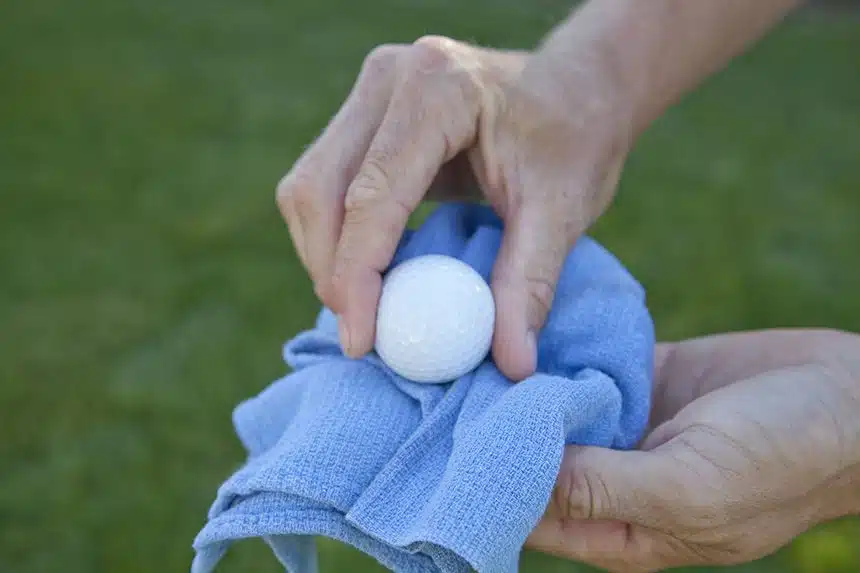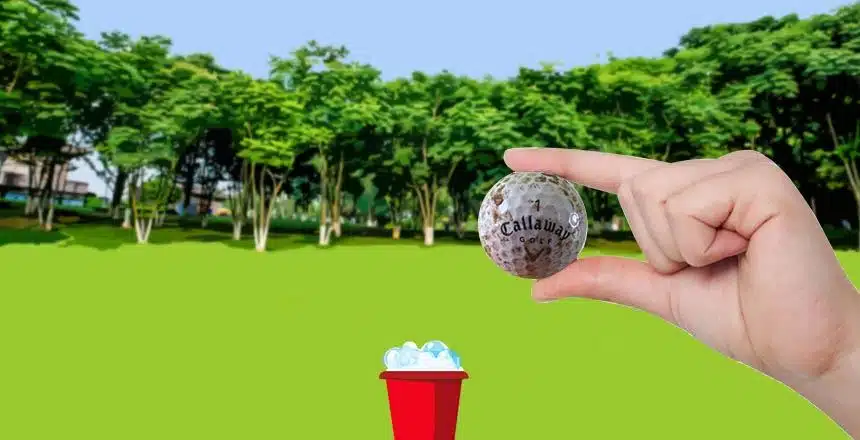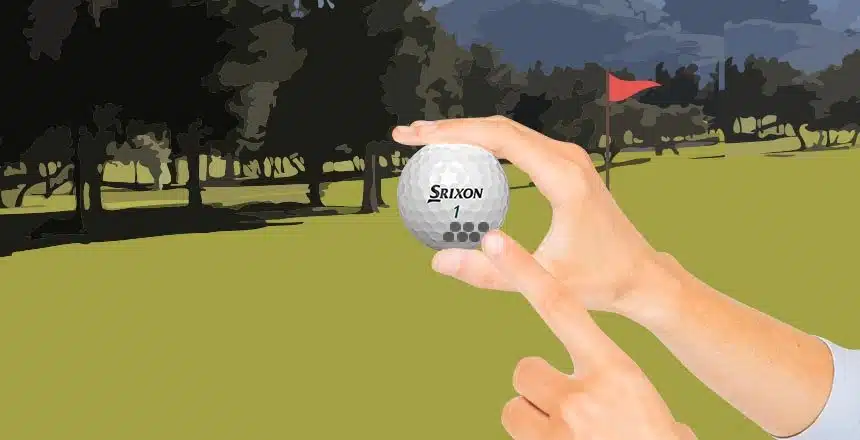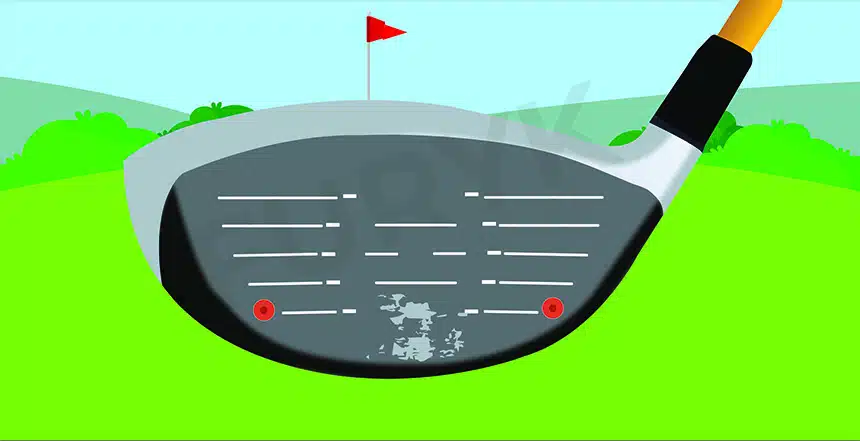Why would anyone want to know how to clean golf balls? Because when clean, golf balls don’t only look better, they are also much easier to locate and find on the fairway, green, in the rough, sand, etc.
Now you must be thinking that you can just as easily rinse your dirty, mucky golf balls on the golf course itself, using a Par Aide just like this…
Now let me tell you that rinsing golf balls this way rarely ever gets rid of all of the mud and dirt. And all these “interfering” physical particles have to be washed away properly if you want your golf balls to keep true to their intended flight path and roll. So let’s find out how to do that the most effectively and quickly at home!
In This Post
Best Method of Cleaning Golf Balls (Using Dish Soap + Bleach)

There’s surely not just one right way of cleaning dirty, muddy golf balls. You can choose from a host of different methods (discussed right after this), such as even washing them in a dishwasher. But, by far, the easiest way involves the use of dish soap, a bucketful of water, and a washcloth. You can scrub away the stains and dirt.
- Fill hot water in a bucket and add a little bit of the dish soap cleaning agent (one cup should be enough). Stir the whole thing properly to get the dish soap to spread out evenly.
- Now soak your golf balls in that hot and soapy mixture of the bucket for at least 30 minutes. This half-hour soak removes most of the surface stains and crusty dirt.
- You can then scrub each ball with the help of a bristle brush. These bristles should be made of nylon by the way, and not wire (because you obviously don’t want to cause damage to the golf ball).
- Then throw away the dirty water and just rinse the golf balls to get rid of any leftover particles and soap.
- And after that, another bucketful of hot water with 1/2-cup bleach this time. Another 30-minute soak here for sterilizing the golf balls (meaning removing algae and fungus) along with getting rid of any discoloration on the balls.
Just please be careful not to use any acidic cleaning solution on the ball as that tends to damage the cover of the golf ball.
And if you want to remove ink, then use nail polish remover.
But then what do you do when the gunk just isn’t coming off? Place these extremely dirty golf balls then in a container and also add denture cleaning tablets in there.
How to Clean Golf Balls At Home
1. Cleaning Golf Balls with Bleach Only
Clean golf balls with bleach, really? If you’re worried about bleach causing any damage here, there’s no need for that. I, just like so many other golfers out there, have used this cleaning agent to shine an umpteen number of golf balls.
Just as long as you’re diluting the bleaching solution with enough water (half-cup bleach with 1-gallon water), you have no cause for worry.
As for soaking your precious golf balls in it, 10 to 15 minutes are more than enough. After which, you do some gentle scrubbing using a rag or brush. And then rinse the balls thoroughly.
No matter how tempting or how dirty your golf balls, DO NOT combine other chemicals with bleach as that might produce toxic gases. Another thing – please put on proper safety gear, such as gloves, when handling bleach.
2. Cleaning Golf Balls with Dish Soap Only
Once again, this is the most convenient, easiest, and economical way of cleaning soiled golf balls. All you need is a bucketful of hot water, some dish soap (one cap should suffice), and a toothbrush for scrubbing.
Soak the balls in the soapy mixture in the bucket for 10-20 minutes. Then scrub off the dirt, stains, and grime. In the end, rinse off everything using clean water and then finally wipe down the golf balls with a clean, dry towel.
3. Cleaning Golf Balls with Hydrogen Peroxide
Another very effective method to clean grimy, greasy, muddy golf balls – cleaning golf balls with hydrogen peroxide. But don’t forget to put on your gloves for this one.
Just a cup of hydrogen peroxide or ammonia (it’s a good alternative to hydrogen peroxide and bleach) per two cups distilled water. Soak the balls for 10-15 minutes. Then scrub away with a non-abrasive brush. Rinse off using clean water and then hand-dry.
4. Cleaning Golf Balls with Vinegar
White vinegar is another harmless way to clean dirty golf balls. Plus, it’s inexpensive and environmental-friendly.
Cleaning golf balls with vinegar requires a bucket filled with warm or hot water, add 1-cup vinegar. The golf balls should soak in this solution for about 20 to 30 minutes. Then remove them from that bucket only to see how vinegar has managed to dissolve a lot of the surface dirt and stains.
So then it becomes easier for you to scrub off or wipe down any remaining gunk before you place the balls under direct sunlight for a bit.
5. Cleaning Golf Balls Recovered From Ponds (Using a Dishwasher/ Washing Machine)
How to clean golf balls from ponds? Pond scum and discoloration are what need to be gotten rid of when you recover your golf balls from the pond. And to do that, a dishwasher seems like the best solution, or a washing machine as well.
In there, the balls that are not waterlogged and unplayable will not get damaged, as opposed to the ones that are. So the former, once washed, you can carry with you for your next round of golf.
And if even after washing golf balls in the dishwasher, there’s still some dirt and/or stains left behind, feel free to soak them in bleach + water mixture for a while after that. Just put on your safety rubber gloves when using bleach. If required, scrub gently using a brush. And finally, rinse them off with clean water.
But Is It Safe to Wash Golf Balls In the Dishwasher or Washing Machine?
Did you know that you can actually load a hundred golf balls into the washing machine and let it do its job just like it does with clothes?
As to how to wash golf balls in dishwasher, it’s really a very effective and quick way of cleaning a whole bulk of dirty, muddy golf balls instead of scrubbing or wiping them manually using a cloth/towel. It’s completely okay to allow golf balls to sit loose and get washed in the machine.
The process of washing even in the dishwater tends to loosen up those stubborn dirt particles, if not get rid of them entirely. So once loosened, it becomes easier to simply just scrub or wipe down those golf balls.
But then if your machine drum is cheaply built, the golf balls in there are likely to damage that part of the appliance. Damage the washing machine though, not themselves for sure.
6. Cleaning Golf Balls with Golf Ball Cleaner
Now for some heavy-duty cleaning, against which thick, heavy dirt doesn’t stand a chance, what really works is legit golf ball cleaner and washer.
While it’s true that detergents and stiff, abrasive brushes do not disappoint when it comes to removing old stains and just renewing the appearance of golf balls. But then, more often than not, these tools also cause damage to the balls, such as large scratches.
Enter properly built, gentle cleaners/washers that feature effective AND gentle cleaning brushes and systems to get your golf balls shiny clean without messing with their anatomy or appearance. Plus, you don’t even need to scrub hard anymore to completely eliminate yellow stains and stubborn dirt and mud particles.
Frequently Asked Questions (FAQs)
What Is the Best Way to Clean Used Golf Balls?
Using dish soap is the best when it comes to cleaning used golf balls. A cap-full of the dish soap cleaning solution in a bucket-full of water. Soak the golf balls in there for 30 minutes or so.
During this time, the soapy mixture makes sure that most of that caked-up dirt as well as old stains are loosened. So you can just scrub it all off very easily and then rinse the balls in the end with clean water.
How to Make Golf Balls White Again?
When you think of getting rid of discoloration, you immediately think of bleach. Half a cup of bleach with hot water. Soak dirty, stained golf balls in this mixture for about 30 minutes to get your golf balls to shine again. Plus, bleach also sterilizes the balls, which means goodbye algae and fungus.
Can You Wash Golf Balls In An Ultrasonic Cleaner?
Commercial water-soluble cleaners are used along with washing golf balls in a machine. This method can take a load of anywhere between 15,000 and 38,000 golf balls per hour. Likewise, ultrasonic golf ball cleaners are also safe and effective.
Do Scuff Marks On Golf Balls Affect Their Performance? (How to Remove Scuff Marks?)
If these scuff marks are small, you don’t have to worry about them interfering with the golf ball’s performance. But then, on the other hand, large, noticeable scuff marks do have an impact on the ball flight. Air drag, then, makes contact not with the un-scuffed part but with the scuffed and damaged part instead.
As to how to get such large scuff marks off, you honestly can’t do much except make the surface of the golf ball comparatively less scuffed by smoothening it out using a soft, gentle scrub brush plus a magic eraser sponge. This way the ball becomes more playable at least.
How to Remove Sharpie Off A Golf Ball?
Once again, turn to dish soap for getting sharpie off a golf ball. Scrub away all the unwanted, dirt particles with the help of a mixture of water and cleaning liquid. Use a towel or washcloth to do the gentle scrubbing.
As for getting rid of ink on golf balls, what actually works is a nail polish remover. But keep away from acidic cleaning solutions because they are most likely to damage the ball’s outer cover.
How to Wash Golf Balls In Bulk?
Use the dish soap and bucketful of hot water method. Let all the golf balls soak in that soapy mixture for around 30 minutes. Then scrub the dirt and mud off every ball using a soft, gentle brush. Throw out the soiled water. Then take another bucketful of hot water with half-cup bleach and soak the balls in that solution for another half an hour.
But if you’re not up for all this manual labor, then just wash your load of dirty golf balls in a washing machine. Don’t worry, they won’t get damaged.
You Now Know Just About Everything In Terms of How to Wash Golf Balls!
Keep them clean not only because they look better that way but also because they perform better. Don’t let dirt, mud, and other such unwanted physical particles get in the way of your golf ball staying true to its genuine flight path and even roll.
Agreed that cleaning golf balls at home demands effort, which is why there are so many quick yet effective ways of going about it.





